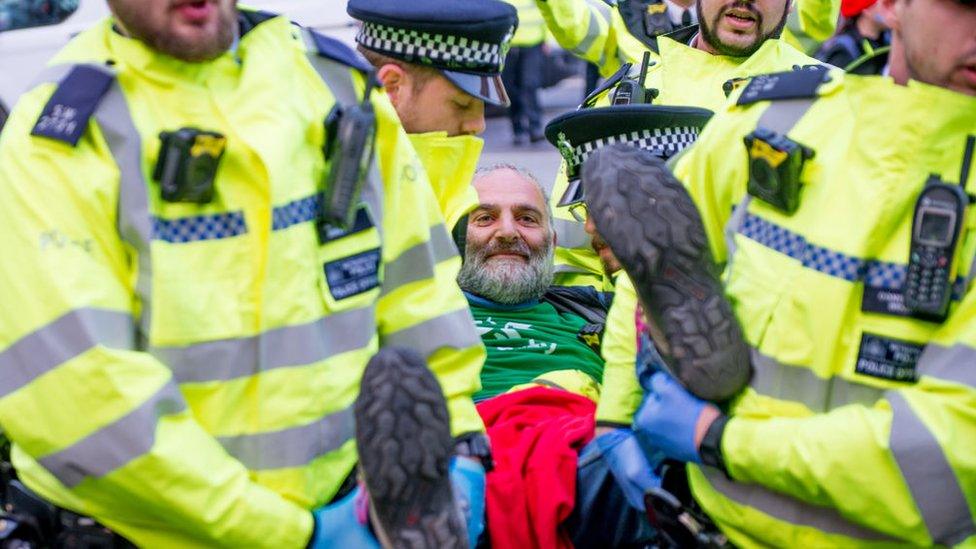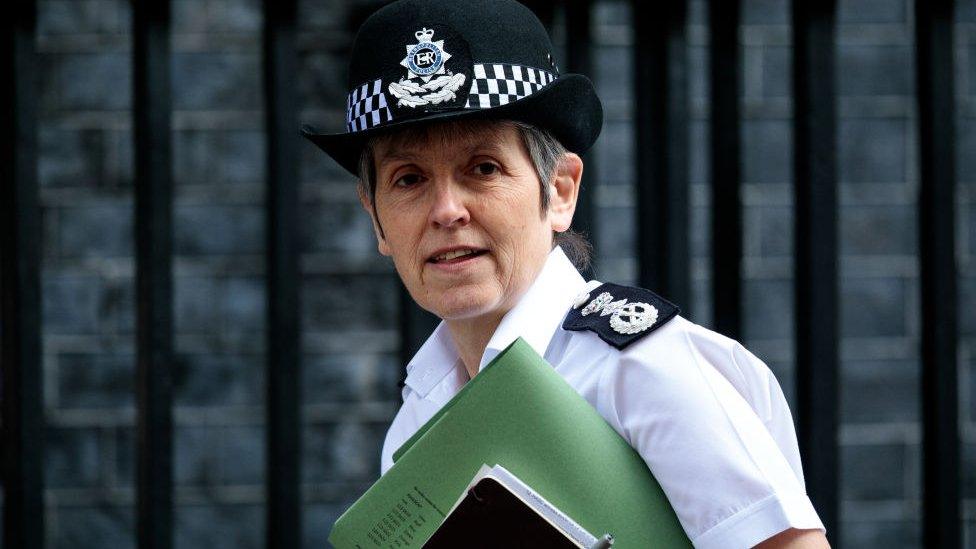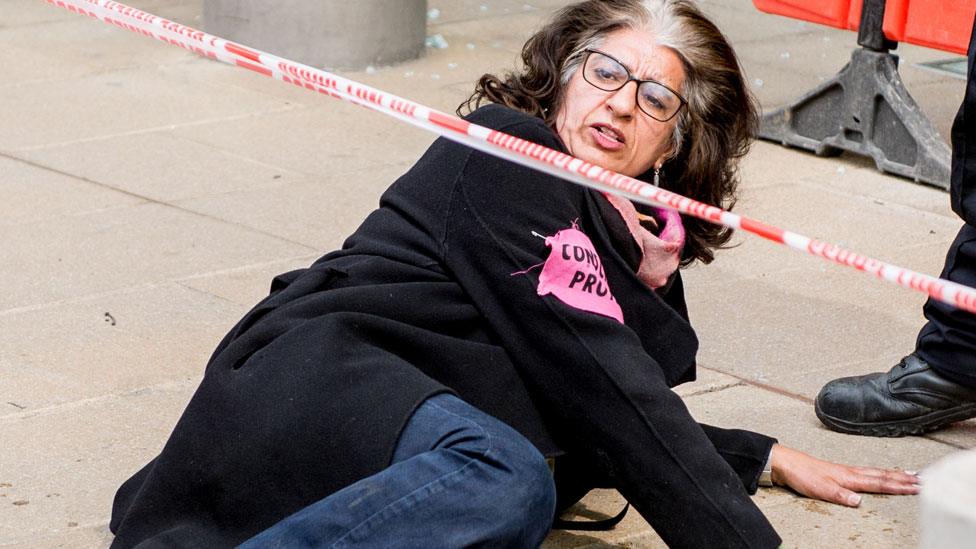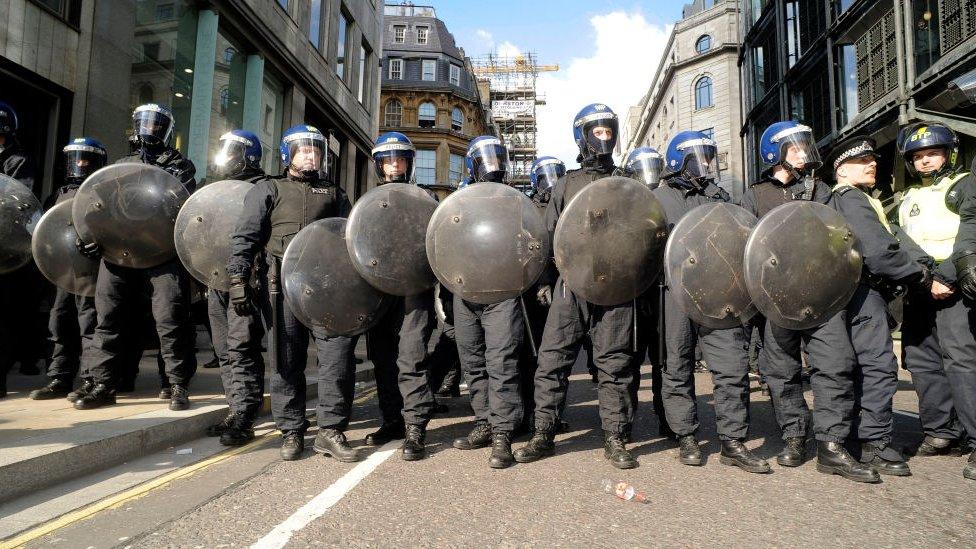Climate protests: How do police control demonstrations?
- Published

Some 400 climate-change protesters have been arrested after several days of demonstrations in central London.
Despite the arrests, the Extinction Rebellion activists say they will continue with their protests, which have caused traffic gridlock in places and disruption to parts of London's public transport network.
Policing of the protests has been criticised by some, but what powers do officers have? And how have their tactics changed from previous protests?
What powers are the police using?
The majority of the arrests by the Metropolitan Police Service, have been for suspected breaches of a Section 14 Notice of the Public Order Act 1986, external.
A "Section 14" is a "direction" that allows the police to impose conditions on a static protest - in other words, one where a group of people gather in one place and stay put - rather than marching somewhere.
Who are Extinction Rebellion?
In relation to the Extinction Rebellion protests, the Met has stipulated that activists should move to nearby Marble Arch if they wish to continue protesting.
If individuals fail to follow the police instructions, they can be arrested and face the risk of criminal prosecution.
The most likely sentence for breaching a Section 14 notice, especially if the convicted person was peaceful and has no recent convictions for similar offences, is a conditional discharge - where a court convicts but does not impose a sentence on the condition a further offence isn't committed.
When are the police allowed to issue a Section 14 notice?
Section 14 notices are quite rarely used, but they can be when police have advance notice of a big protest.
Police officers can issue them if they "reasonably believe" that the protest "may result in serious public disorder, serious damage to property or serious disruption to the life of the community". They can also be be used if the police believe the purpose of the protest is to intimidate others.

Met Commissioner Cressida Dick briefed the home secretary about the protests
But protesters need to be aware that police have issued a Section 14 direction in respect of the protest before they can be arrested for a suspected breach.
Police will often try to communicate that a Section 14 notice is in force through various means - for example, handing out leaflets, using social media or using a megaphone to address a crowd.
But why isn't everyone being arrested?
Officers have discretion over whether to make arrests. The Met said in a statement: "These are peaceful protesters; while disruptive their actions are not violent towards police, themselves or other members of the public. We are looking at other tactics such as tighter police cordons."
In any protest, the police might take the view that attempting to carry out mass arrests could cause trouble - so by "waiting it out" they hope that the demonstrations might gradually wind down of their own accord.
There is also a question of resources.

One activist, Farhana Yamin, glued her own hands to the pavement outside Shell's headquarters
One police officer at one of the protest spots told the BBC their tactic was to move people one-by-one.
The officer added that while everyone was "technically arrestable", there were not enough officers to carry out mass arrests.
Furthermore, there have been reports of some of those arrested being sent as far as Bromley, south London, due to a lack of police cells in central London.
According to a 2017 Freedom of Information request, the Met has 683 cells across 27 custody suites, external.
In response to concerns over capacity, the Met said it had "contingency plans" should cells become too crowded but refused to discuss its plans further for "operational reasons".
How do the police tactics compare with previous protests?
On May Day in 2000, the Metropolitan Police Service was accused of losing control of Westminster and the West End during a major anti-capitalism protest, external.
There were running battles between officers and anarchist groups which led to significant damage.
The following year, when some of the same groups returned, the Met responded in force.
Thousands of officers used a tactic known as "kettling" to corral crowds until they were trapped in what amounted to a human pen at the very same Oxford Circus location now occupied by Extinction Rebellion.
Some of the protesters turned violent - but many others were entirely peaceful and angry at being "kettled", external and unable to leave.
Police identified the "trouble-makers" and sent in snatch squads to arrest them. It took seven hours for the city to return to normal and the crowds to be dispersed.
Kettling became the subject of an 11-year legal battle, which resulted in the European Court of Human Rights declaring that it was lawful.
That landmark judgement meant the police could use this exceptional containment power if there was a genuine risk of violence.
In 2005, more than 350 people were arrested, external at the Gleneagles G8 leaders' summit in Scotland following violent clashes between protesters and police.
Extinction Rebellion is different because there is no threat of violence - just occupation and disruption, aided by DJs, mobile curry stalls and the occasional juggler.

The 2019 Extinction Rebellion protest has focused on occupation and disruption
So do the police have other tactics?
In 2009, demonstrations against the UK meeting of G20 world leaders saw both peaceful and sporadically violent protests in London.
Climate Camp, one of the peaceful demos, was similar to Extinction Rebellion. It was a sudden, no-notice occupation of a part of the City of London - home of the Bank of England and other financial institutions - which police couldn't stop.
By early evening, the Met's commander on the ground was concerned there was going to be trouble - not from the Climate Campers, but from the dispersal of another nearby group which he feared could infiltrate the peaceful street occupation.
His officers issued Section 14 orders telling the Climate Campers to depart by 19:00. When they failed to leave, he contained them while his officers dealt with the other group.
What happened next deepened the controversy. Lines of police with riot shields and batons raised pushed through the Climate Camp to break up the occupation.

The police "kettling" tactic was used during the 2009 G20 protests
Eventually, after another mammoth legal battle, the courts backed the Met's decision-making that night, saying the commander was entitled to judge that violence would have been imminent had he not used the containment and dispersal strategy.
It's worth pointing out that while the Met has won these two key legal cases over kettling and dispersal, a far more serious incident happened during the G20 protests.
Ian Tomlinson, an entirely innocent newspaper vendor died after he was pushed over by a police officer as he tried to head home.
An inquest jury found he had been unlawfully killed and the officer was later tried - but acquitted of manslaughter.
No commander in charge of policing protests wants to go through that experience again.
And that's why the right approach to containing and potentially dispersing a disruptive street demonstration on the scale of Extinction Rebellion comes down not only to the law and police resources, but the mood on the ground and some intelligence about the intentions of the demonstrators.

